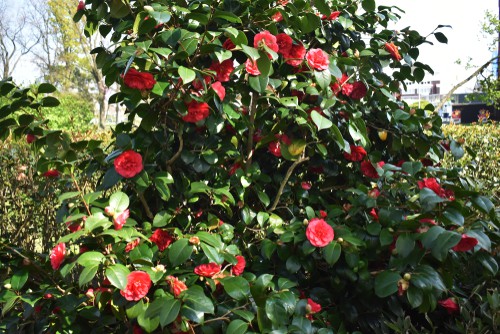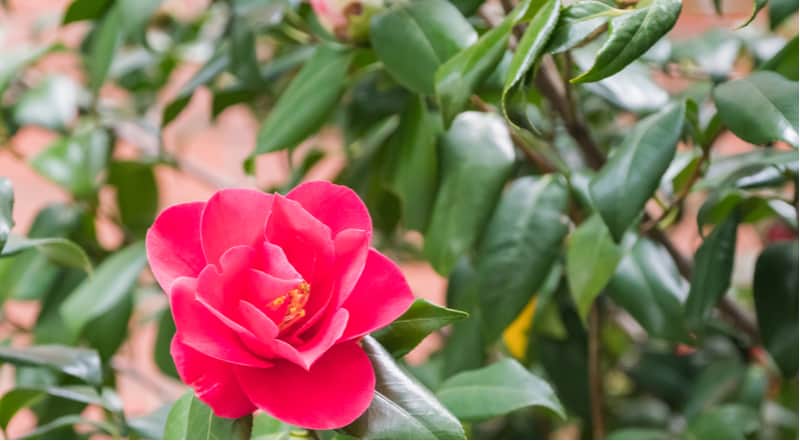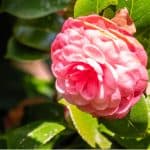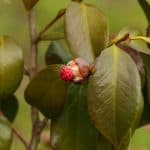Last updated on March 23rd, 2022
Our site is reader supported, this means we may earn a small commission from Amazon and other affiliates when you buy through links on our site.
Camellias are beautiful shrubs that offer large, stunning flowers in conjunction with glossy, green leaves. They are typically reliable bloomers but there may be an occasion where your’s just simply isn’t flowering. This is, of course, very frustrating, especially when you know that your Camellia is otherwise perfectly healthy but is still refusing to bloom. So what reasons are there for your Camellia not flowering? This article will help you narrow it down.
Firstly, if your issue is that of bud drop, (the buds just drop off before they become flowers) this is normal to an extent. Some buds will usually fall off, however, uneven watering can also cause bud drop, but more on this further down. What if there are no buds, and no flowers? Well, this is usually because of stress.
What causes a Camellia to not flower?
Plant them in a more sheltered position to protect against cold winds
Camellias are very sensitive to cold weather and are very early to flower, with bud formation during the winter, making them a little more sensitive to cold weather. If you have a late frost where you live or a particularly cold wind snap, it can damage the buds. The result of which is that they fall to the ground prematurely and you don’t get any flowers. Cold weather is one of the most prominent stressors for early blooming Camellias, especially in English gardens. Planting them in a more sheltered position where it is protected from cold winds can help avoid this.

They are planted in a position with too much shade
Tangentially, too much shade can prevent flowers. Camellias need to be planted somewhere they will receive at least morning sunlight with afternoon shade or filtered sunlight all day long but certainly not a really shaded area all day. If they are in a location where they receive too much shade, you might want to consider moving them elsewhere in your garden or planting them in a container so that you can transfer them around the garden, chasing the sun.
Something to note is that after the buds have formed, frost can cause them to shrivel up and turn brown. Sunlight should not be allowed to fall on frosted buds before the ice has melted, so avoid east-facing sites if possible.
Uneven watering – keep the soil moist but not soggy
Uneven watering is another type of stress. If you don’t water evenly or the soil is too wet because you have been watering too frequently, the buds can drop prematurely. This is especially important when the buds are forming. Camellias, like most plants, don’t like having wet feet so you want to keep the roots dry, with properly draining soil.
Too much fertiliser causes excessive foliage growth and fewer flowers
 Only feed in spring after flowering with a slow-release fertiliser. Available from Amazon.co.uk
Only feed in spring after flowering with a slow-release fertiliser. Available from Amazon.co.uk
Too much fertiliser can reduce blooming. You should be feeding your Camellias with a specially formulated fertiliser for acid-loving plants, as explained in this article. While you can fertilise them in the early spring and the middle of summer, if your plant is in its first year, you shouldn’t be fertilising at all, except for when you actually plant it.
You also shouldn’t be fertilising in the autumn or even too late in the summer because that can leave your second round of flowers and new growth susceptible to frost damage when the cold weather happens prematurely. This can damage the growth that will produce the buds.
Bud mites
Bud mites are a tremendous pain and one of the only non-maintenance-related causes of failure to flower. These tiny insects will actually eat the buds so they could be causing the premature death of your flower buds. If you notice signs of bud mites, you can spray insecticidal soap or horticultural oil, however, you want to avoid pesticides because at this point in its growing stage, beneficial insects that prey on unwanted pests are also snooping around and a pesticide would kill them as well.
How to encourage more flowers
The best way to encourage more flowers is by planting them in acidic soil or ericaceous compost. Position them where they will receive the morning sun and afternoon shade, or dappled shade all day and feed in spring after flowering with the correct feed. Keep soil moist, especially when the buds are forming. Proper care will help avoid most issues gardeners face with Camellias not flowering.
Overall, look for pests, and keep a close eye on your feeding and watering schedule to help encourage better blooms.



